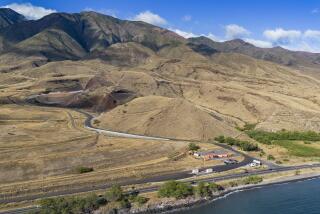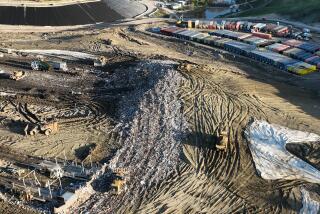Coyote Canyon Landfill Is Poor Place for Building an Ecosystem
* The (San Joaquin) Transportation Corridor Agency recently received approval from the Orange County Board of Supervisors to use the Coyote Canyon landfill as their mitigation site for the destruction of coastal sage scrub that occurs during construction of the San Joaquin Hills Transportation Corridor.
Though other landfill restoration projects throughout the United States have never reproduced complex ecosystems like that of coastal sage scrub communities, the TCA has said it has every confidence that it will design a plan that will be successful.
Yet in August of 1992, The Times reported that many of the same developers involved with the TCA have let wetland mitigation projects throughout the county fail, or at best produce a monoclone preserve with extremely limited biodiversity.
Having studied restoration and mitigation at UC Irvine’s School of Social Ecology, I know that wetland restoration is more easily accomplished than coastal sage restoration on top of a landfill.
Is this responsible management of our environmental resources? The County Board of Supervisors invests public land into a project that has no past evidence of success and allows the TCA to design the project, though other mitigation projects designed by the same developers (who are legally obligated to ensure success) have failed to reproduce viable habitats. These actions show that the supervisors and the TCA have little concern for environmental management.
The Irvine Co. (a member of TCA) owns a great deal of land near UC Irvine (Bommer Canyon area) that suffers from overgrazing and severe erosion. Wouldn’t it be logical for the Board of Supervisors to make the TCA donate some of this land that really is in need of restoration rather than approve a publicly subsidized site with considerable uncertainty for success?
And to ensure a successful design at minimal costs, the supervisors and TCA should use the resources available through UCI, which employs a professor who is an authority on coastal sage scrub restoration and has a following of students dedicated to restoration. Is it too risky for our supervisors to force developers to be responsible about environmental management and to look for innovative solutions for these issues?
PERRY GALLAGHER
Irvine
* I cannot believe that anyone could suggest transplanting an endangered species to the Coyote Canyon landfill! There can be no question that this landfill site contains tremendous amounts of toxic waste which has been deposited over many decades. Methane gas generated by decaying garbage and lawn clippings, when combined with the volatile vapors of that toxic waste, creates deadly and explosive gases.
Laura Coley Eisenberg, senior environmental analyst for the San Joaquin Hills Transportation Corridor Agency, thinks that this will be corrected by a layer of tar paper, some topsoil and some venting structures.
Transplanting an endangered species to the Coyote Canyon dump is laughable.
STEVE JOUVENAUT
Laguna Beach
More to Read
Sign up for Essential California
The most important California stories and recommendations in your inbox every morning.
You may occasionally receive promotional content from the Los Angeles Times.









